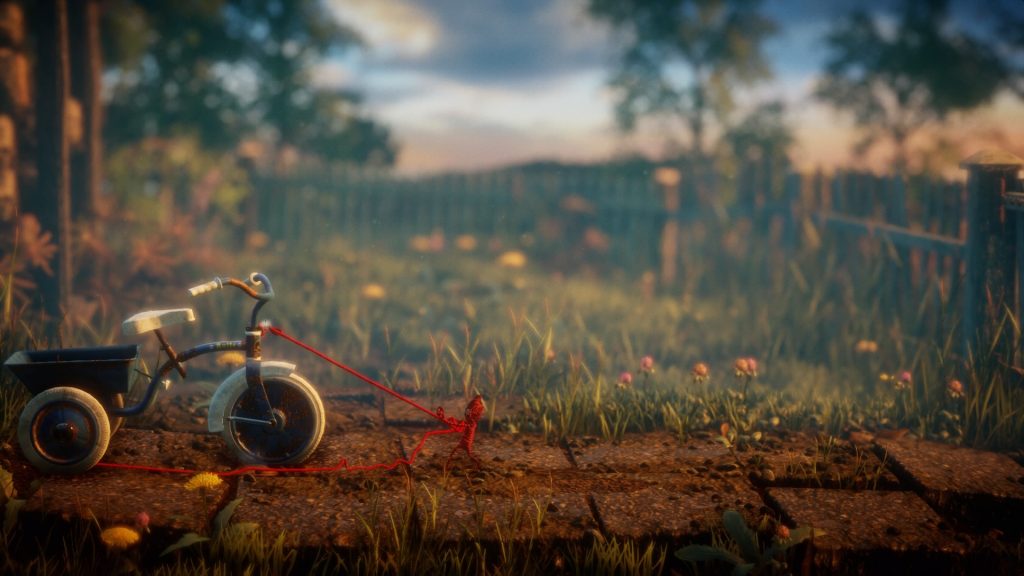Unravel is the equivalent of looking at your very talented photographer friend’s holiday shots. Their photos of mountaintops and luscious forests look absolutely brilliant and are some of the finest photos you’ll ever see, but unfortunately no matter how many stories they tell of journeys through the countryside and treks over mountains, you find yourself disconnected from their passion for the journey. Your eyes glaze over and you think about what you’ll have for dinner tomorrow while they tell a story about carving their lover’s initials in a tree trunk, even though moments before they complained about a mining site existing in the middle of a mountain range.
This is a beautiful game, there’s no denying that. As we begin 2016, Unravel proves that it is one of the finest looking gaming creations available right now with some glorious, almost-photorealistic landscapes. All shades of green are displayed here in varying capacities – from the dark green forests, through to the phosphorescent green of nuclear waste – you’ll see shades of green you didn’t know existed. The feeling of being immersed in nature is strong and helps to push the theme of respect for the world around you and appreciating nature to its fullest.
Through these wondrous vistas, you navigate a red woollen creature named Yarny. Spawned from a yarn ball that an elderly lady drops in her house, Yarny exists as a grand metaphor for appreciating the world around you. In the real world, Unravel‘s creator was inspired to create Yarny when on a family holiday in Scandanavia. After collecting some red yarn from a stranger, and finding some discarded wire, the game’s protagonist was born. Unravel helps transport you to a part of the world that feels unique and otherworldly.
As each level comes to an end, Yarny can flick through a family album of photos, which partially relate to the environment that’s just been traversed. These are presumably photos that were taken on that aforementioned family holiday. After looking at this photo album, you navigate Yarny through a house to a framed picture, where the next level begins. It’s a nice idea to frame each level as if it’s taking place in a person’s memory, but unfortunately the exceptionally run-of-the-mill and generic themes make it difficult to properly connect with the themes presented. Unfortunately, the story itself is exceptionally vague, a problem that only manages to distance the player. Unravel wears its heart on both sleeves, but its earnest nature means little if there is no substance or depth to the images of parents with kids or lovers walking together. These generic images (which wouldn’t be out of place in an Ikea catalogue) may trigger an emotional reaction from some, but it will leave most feeling empty.
I know it’s not fair to compare one game’s vague themes against another’s vague themes, but it’s hard to not escape the fact that Journey achieved the ‘open for interpretation’ theme much better. Of course, not all games need to be ‘about something’ or have players in tears at the end. That’s where we come to Unravel‘s platform mechanics.
As Yarny navigates the world, the red yarn that makes up its body slowly unravels, leaving a trail behind the red gender-neutral creature. Using its yarn, Yarny can swing from context-sensitive hooks within the environment (such as tree branches or well-placed nails) as well as to create bridges between points. These ‘bridges’ can be used to move items between points or slingshot to higher vantage points. At its core, this navigation is simple and oddly therapeutic. There’s something pleasing and calming about swinging from point to point in video games, and Unravel‘s beautiful visuals combined with the gameplay mostly makes for a good experience. Mostly.
Unravel truly shines when its core mechanics work, but sadly this is often not the case, mostly being hampered by repetitive puzzles and imprecise moments. More often than not, the puzzles seem to have the same solution – create a bridge between two points, move an item over this bridge, progress. This is made all the more frustrating as there are many moments that could have been further developed to create stunning set pieces or challenging puzzles. Unfortunately, if you’ve seen the announcement trailer, you’ve seen the majority of the ‘big set piece’ moments – such as hooking a line on a fish and going for a ride. By developing greater set pieces, it would have made the somewhat forced emotional elements of the ‘story’ have a greater impact.
As for those imprecise moments, often I would find myself trying to navigate past a puzzle or a ledge, only to think that I wasn’t doing the right action. I would throw out a length of yarn to catch on a hook that would be the same distance as one that I’d successfully reached before, only to find my yarn falling short and missing its intended point. A couple of times, I had to refer to a walkthrough video because I was stumped as to what I needed to do to progress, only to discover that what I was doing was right and I just wasn’t being as precise as the game required. Now this doesn’t mean that Unravel is broken, it’s just a little finicky and has a lower margin of error than it perhaps should.
Further riffing on Journey is the inclusion of a sublime score. Created using local Swedish composers, this adaptive score is impactful in the right places. While maybe not up to the same level as Austin Wintory’s great score for Journey, it is still one that I look forward to revisiting down the line. Without this great score, the overall experience would be lessened. It’s unfortunate that every element within the game isn’t running on as high a level as the visuals and score is.
It’s obvious there was a lot of love and attention put into creating this game, and it’s evident that the family photos and dedication to the environment means a lot to the developers, it’s just disappointing that the conduit to these memories (Yarny) is a bland, empty vessel. Where the wanderers in Journey were able to communicate with symbols and noises, Yarny is simply a wide-eyed explorer making its way through the world, exhibiting no signs of personality. It’s fine for a character to be a conduit for the player to experience the world, but for a game that tries to include a strong emotional element in it, it’s not enough to simply have a cute figure and expect the player to fill in the blank spaces. This is not to say that Yarny should have a voice or anything like that, more that this red devil-looking creature is simply so blank that it’s hard to care when it manages to die because of a poorly timed jump, and conversely hard to cheer when that same jump is eventually successfully made.
For a game that’s all about respecting nature and experiencing the world, it’s slightly confusing that a fair amount of the animals that you interact with are hostile towards Yarny. Take the little mole-like creature that Yarny encounters underground – its first reaction is to try and eat Yarny, and then a later encounter has it chasing Yarny down a dark tunnel. Bundle the occasional aggressive animal and the imprecise mechanics together, and it further distances the player from being able to immerse themselves in the wondrous world. That’s not to say all animals here are out to kill you, rather that the set pieces related to animals feel excessively oppressive at times and at odds with the greater theme of the game.
Unravel likes to preach about respecting nature, yet the emotional through line is solely focused on humans. Maybe I’m an overly cynical person, but I found it hard to appreciate this desired connection with the people displayed in these photos, especially when the game also shows the destruction that mankind has had on nature. Random ‘memories’ (which act as set dressing) appear in the background of levels of people existing in nature, and appear to reinforce a ‘go out and experience nature’ theme that again lacks any real impact.
So, with all of that in mind – the combination of the bland themes, the beautiful visuals, the vacant Yarny, the great score, the imprecise mechanics, the repetitive puzzles – I have to ask myself, why am I already on my third play through? What keeps me coming back to Unravel even though I find the whole experience underwhelming? With all its problems and frustrations, Unravel is an oddly calming experience. There is nothing exceptionally ground-breaking here, even though it really wants to be ground-breaking and impactful. On paper, there are a lot more issues than there should be in a game that is actually not that bad to play through. When I’m in the world of Unravel, I find myself enjoying my time with it, even though every minute or so I’m cursing because I’ve missed a jump or have died an unfair death. It falls far short of what its desired goal is, but its ambition and desire to reach those lofty emotional heights is enough to make Unravel a tolerable, yet flawed platformer. In that regard, for platformer fans out there, this is a game that is worthwhile playing through when it’s on sale or you have run out of other platformers to play. For everyone else, unfortunately, this is a game I struggle to recommend to pick up.
Buy Unravel on XBox, Playstation, or Origin




